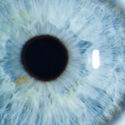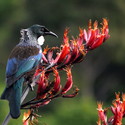Wētā have been in New Zealand for around 190 million years. Do they live on school grounds? And if so, what do they eat at mealtime?
These were some of the questions students at Bairds Mainfreight, Dawson and Rongomai Schools wanted to answer. They teamed up with Dr Stéphane Boyer from the Unitec Institute of Technology to learn about wētā habitats1, conservation2 and genetics3. Their innovative study is a Participatory Science Platform (PSP) project supported by the New Zealand Government.
Hands-on and six-spiny-legged-feet-on activities
Students from the three schools began their project with an interactive Wētā Day hosted by Bairds Mainfreight School. Students rotated around eight stations. They experienced wētā in many ways – from an art perspective to handling live species4 to using virtual reality5 to experience life as wētā in a bush setting. The students were also introduced to DNA6 analysis and used microscopes to examine wētā poo – or frass7.
The students then learned about wētā motels – small structures they could place within their school grounds to attract local wētā. The wētā boxes had sliding doors enabling students to observe what’s living inside the boxes and collect frass. By using DNA technology, students could identify the plant species the wētā had eaten. This information will act as a guide to future plantings, helping students choose plants that will turn their schools into wētā-friendly habitats.
School visits by the science team
During the second phase of the project, Stéphane visited each school. Classrooms became laboratories as Stéphane set up DNA analysis equipment.
First, the students learned how to prepare samples. They ground up granules of wētā frass. Students used chemical solutions and multiple spins in a centrifuge8 to break down cell9 membranes and isolate DNA from the cells’ nuclei10. The next step was to amplify11 (makes lots of copies of) the DNA to make it easier to see. Finally, Stéphane and the students used gel electrophoresis12 to separate the DNA molecules13 and make them glow under ultraviolet light. The result? DNA barcodes from the different wētā food sources.
The final part of the research project took place in a Unitec lab. Stéphane needed a sterile14 location to conduct the DNA sequencing15 to prevent contamination16 from other DNA sources. The students observed the process and interacted with Stéphane via Skype. Stéphane will match the DNA codes collected from the schools with DNA from specific New Zealand plants.
Rich discussions and meaningful learning
Dawson School teacher Tarayn Zeier reports, “The students gained a lot from this opportunity, as they got to experience things that they had not previously experienced or thought possible. This was especially beneficial to engage learners in a new and exciting way. My ESOL students in particular were very enthusiastic when sharing what they had learned and enjoyed becoming ‘wētā experts’. The rich discussions that took place before, during and after our sessions allowed students to be involved in a meaningful learning experience where they weren’t restricted by language barriers or lack of prior knowledge.”
Research findings
Stéphane says that wētā are not very common on the schools’ grounds. He thinks that school environments are often too tidy, and the gardens don’t contain the right kinds of plants. But now that the students are wētā experts, they want to make more wētā-friendly habitats so they can continue to learn about these nocturnal17 natives.
Ongoing research
The students also realised that the houses they had been using were not ideal, so they took it upon themselves to design a wētā house that is safer and more desirable to wētā. Read about their efforts and their new prototype18 in the article Redesigning wētā houses.
Genetics, conservation and biodiversity
Using DNA analysis to study insects’ diets is an engaging way to introduce students to DNA technology, but how does this link to conservation science?
Nature of science
Technology has changed the way we understand species and species diversity and how we make conservation decisions.
By using traditional methods – a microscope19, for example – it is possible to find seeds in wētā poo. This shows what fruits the wētā ate, but wētā eat more than seeds – they also eat leaves and small insects. DNA analysis can identify exactly what foods wētā have eaten.
Research using DNA analysis has even determined that tree wētā are unlikely to aid native20 plant seed21 dispersal22 as seeds are destroyed in their digestive23 process.
DNA analysis also allows for more accurate classification24 of species. For example, there are more than 100 species of wētā in New Zealand. Genetic25 information helps conservationists identify which wētā species are present in particular locations. It also helps to identify what they eat. This information is important when translocating26 and managing wētā for conservation purposes.
On a very different scale, New Zealand’s Biological Heritage National Science Challenge is using environmental DNA – often called eDNA – to help identify and profile biodiversity27 across an entire ecosystem28. eDNA is collected from soil or water samples rather than an individual organism29. This new technology has the potential to fill large gaps in our knowledge of New Zealand’s unique biological communities.
Wētā and conservation science
Find out more about these fascinating nocturnal creatures and how to host them in your school with Hub resources Wētā and Building homes for tree wētā.
Read about two conservation techniques used with wētā and other native species: captive management and translocation. The activity Exploring genetic variation encourages students to consider the need for genetic diversity30 when conserving native animals.
DNA analysis
Learn more about some of the methods Stéphane and the students use to analyse wētā poo in the videos What is PCR? and Pulsed field gel electrophoresis.
Related content
Find out how other sources of poo are helping to monitor lakes and other ecosystems31 in the article Environmental DNA and the activity Finding out what’s in our lake using eDNA.
Useful link
Read the Dawson Primay School students' blog for some great accounts in their own words.
Funding
Dr Stéphane Boyer, Bairds Mainfreight, Dawson and Rongomai Schools received funding for their wētā project through the South Auckland pilot of the Participatory Science Platform (PSP) – a programme that is part of the Curious Minds initiative and funded by the Ministry of Business, Innovation and Employment.
The South Auckland pilot of the PSP is managed by COMET Auckland (Community Education Trust Auckland).
The government’s National Strategic Plan for Science in Society, A Nation of Curious Minds – He Whenua Hihiri i te Mahara, is a government initiative jointly led by the Ministry of Business, Innovation and Employment, the Ministry of Education and the Office of the Prime Minister’s Chief Science Advisor.
- habitat: The natural environment in which an organism lives.
- conservation: The protection, preservation and careful management of a species, habitat, artifact or taonga.
- genetics: The study of heredity and variation in living organisms.
- species: (Abbreviation sp. or spp.) A division used in the Linnean system of classification or taxonomy. A group of living organisms that can interbreed to produce viable offspring.
- virtual reality: A digitally generated environment that a person can interact with using specialised equipment such as a virtual reality headset.
- DNA: Deoxyribonucleic acid (DNA) is a molecule that contains the instructions needed for an organism to develop and function. These instructions are stored as a code made up of four chemical bases: adenine (A), guanine (G), cytosine (C) and thymine (T).
- frass: Insect excrement.
- centrifuge: (Noun) A machine that rotates at high speed that is used to separate materials of different densities.(Verb) To rotate at high speed.
- cell: 1. Building block of the body. A human is made of millions of cells, which are adapted for different functions and can reproduce themselves exactly. 2. A simple electrolytic device that enables chemical energy to be transformed into electrical energy.
- nucleus: 1. The very small, very dense, positively charged centre of an atom containing protons and neutrons. 2. Part of the cell that contains the cell’s hereditary information (DNA) and controls the cell’s processes.
- amplify: To make many copies of a stretch of DNA, particularly by means of polymerase chain reaction (PCR).
- gel electrophoresis: A laboratory technique used to separate molecules, such as DNA, RNA and proteins, according to their size and charge.
- molecule: Two or more atoms bonded together. The molecule of an element has all its atoms the same. The molecule of a compound has two or more different atoms.
- sterile: Free from contaminating organisms, like bacteria or viruses, that may transmit disease.
- DNA sequencing: A technique used to determine the exact sequence of nucleotides in a sample of DNA.
- contamination: The introduction of contaminants into a substance.
- nocturnal: Active at night.
- prototype: A trial working model or preliminary version of something. Sometimes a prototype might be smaller than the final version of an engineered object, so that the engineers can check if the design works before committing themselves to large-scale commercial production.
- microscope: An instrument that uses a lens or a series of lenses to magnify small objects.
- native: A species that lives naturally in a country, as opposed to species that have been introduced by the activity of humans.
- seed: 1. Part of the sexual reproduction of angiosperms (flowering plants) and gymnosperms (cone plants). Contains an embryo and its food store, which creates a new plant when conditions are right. 2. Offspring or progeny.
- dispersal: Movement of an organism to a new place. Seeds in plants and spores in ferns and fungi help dispersal by floating on the wind to new habitats. This allows stationary species to colonise new areas.
- digestive system: The group of organs that are involved in the breakdown of food in the body, which includes the stomach and intestines.
- classification: To arrange or organise by a set of chosen characteristics. In biology, the process of ordering living things into a system that allows scientists to identify them. Modern science uses the Linnaean system of classification where organisms are grouped based on what species they are most closely related to. In soil science, the grouping of soils with a similar range of chemical, physical and biological properties into units that can be geo-referenced and mapped.
- genetic: Of, relating to, or determined by genes.
- translocation: When plants or animals are transported to a new area to establish a new population or to add genetic diversity to an existing population.
- biodiversity: The range of species found in a particular region. The more species that exist (the higher the biodiversity), the more likely it is that an ecosystem will survive episodes of change.
- ecosystem: An interacting system including the biological, physical, and chemical relationships between a community of organisms and the environment they live in.
- organism: A living thing.
- genetic diversity: The variety of genetic material within a single species of organism that permits the organism to adapt to changes in the environment.
- ecosystem: An interacting system including the biological, physical, and chemical relationships between a community of organisms and the environment they live in.








